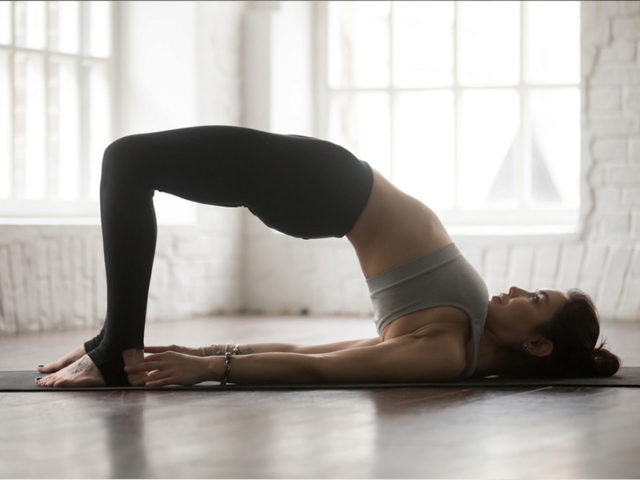Polycystic ovary syndrome (PCOS) is a common disorder associated with the hormonal or endocrine system of the female reproductive system. Irregular periods, unexplained weight gain, excessive facial hair can all be symptoms of PCOS. Surprisingly, most women with PCOS don’t even know they have it. Take this quiz to see if you may have PCOS, click here. Trying yoga for PCOS can yield great results and there are almost zero side effects. Apart from yoga asanas, even meditation can help resolve menstrual issues. Meditation has been demonstrated to improve the physical and emotional symptoms of PMS. Find your ultimate guide to navigating PCOS here. Are you tired of your monthly period pains? No worries, check out how you can do yoga for irregular periods and enjoy your “that” days too.!
10 Effective Yoga Asanas For PCOS
It has been observed that yoga for PCOS can help open up the pelvic area. It also releases deeply stored stress and promotes relaxation of the mind and body. By practising these asanas regularly, women can de-stress and facilitate detoxification of their body. Relaxation is the key in PCOS. Ensure to relax in each asana by coordinating it with breathing. Take long and deep breaths as you perform each posture. Find 7 yoga postures to treat hormonal imbalance here.
1. Malasana (Garland Pose)
Malasana can strengthen the pelvic floor and abdominal core while opening the hips. This can benefit individuals with PCOS by increasing circulation and blood flow to the pelvic region, improving metabolism, and aiding digestion.
How to do it:
- Start with feet spread about a mat’s width apart.
- Bend your knees and lower your buttocks toward the floor to come into a squat position.
- Bring your hands in a prayer position (Anjali mudra). You can allow your thumbs to touch your sternum to help keep the chest lifted.
- Press your upper arms/triceps inside of your knees and stay engaged with your spine straight (elbows press into knees to open the hips).
- Extend the low back and draw the shoulder blades towards one another.
- Remain in this position for up to 5 breaths.
- Come out of it by straightening your legs.
- Repeat the pose three times.
2. Bhujangasana (Cobra Pose)
Also known as the cobra pose, this asana helps you promote flexibility in your body and de-stress your system. This video also shows Paschimottanasana and Paschimottanasana, read further to learn more about these asanas. Accompany this yoga pose with deep breathing exercises to relieve stress and anxiety, learn about them here.
How To Do It:
- Lie down on your chest with your elbows close to your body, palms facing down.
- On an inhalation, slowly straighten your arms to lift your chest off the floor and keep reclining back. Your navel should be touching the floor.
- Hold the posture for 15-30 seconds and then gradually exhale and come back down.
3. Ustrasana (Camel Pose)
The camel pose causes stretching in your abdominal region. The pull in your stomach signals your uterine muscles which ease your menstrual cramps. This asana also stretches the spine which relieves mild lower back pain.
How To Do It:
- Kneel on the floor.
- Arch your back slowly.
- Touch your heels with your hands.
- Hold this for 30 to 60 seconds.
4. Dhanurasana (Bow Pose)
Dhanurasana is one of the best poses for your reproductive system. It increases circulation to the pelvic region, releases tension from abdominal organs, and also stretches the neck, shoulders, and legs muscles. Learn 10 asanas that boost fertility in women here.
How To Do It:
- Lie face down.
- Lift your hands and feet.
- Join hands and feet above your body and hold them.
- Continue holding for 30 seconds and repeat.
5. Paschimottanasana (Seated Forward Bend Pose)
This asana calms the brain and helps relieve stress and mild depression that can be common while PMSing. It also helps relieve the symptoms of menopause and menstrual discomfort.
How To Do It:
- Sit with your feet straight in front of you.
- Exhale as you stretch your body towards your feet.
- Hug your feet with your hands and hold for one minute.
6. Chakravakasana (Cat-Cow Pose)
The Cat-Cow Pose is also high on the go-to list for PCOS. Yoga promotes calorie burn in the body by pumping up the metabolism and managing your weight. Find 5 yoga poses that will help improve your gut health here.
How To Do It:
- Get in a tabletop position with your palms down, wrists and elbows aligned under shoulders, knees under hips, ankles straight back from the knees. You can curl the toes under or tops of the feet down, as the flow moves you.
- Inhale, bend the elbows, lower the belly, lift the chin and the tailbone simultaneously, moving each of the vertebrae of the spinal column in a wave.
- Reverse the movement on the exhale by tucking the tailbone and chin, and doming the back as you draw the navel toward the spine as the chin tips toward the chest.
- Repeat for the desired amount of times.
7. Setu Bandha Sarvangasana (Bridge Pose)
Bridges are not only one of the best exercises for a sculpted butt, but they will also help keep your back healthy and pain-free. It helps eliminate period cramps with ease. Place a block under your sacrum (tailbone area) for added support, especially if your back pain is intense.
How To Do It:
- Lay face-up with your knees bent and your feet flat on the floor.
- Raise hips so your body forms a straight line from your shoulders to your knees.
- Pause in the up position, then lower your body back to the starting position.
8. Supta Virasana (Reclining Hero Pose)
The reclining variation of Virasana is an intermediate pose. It helps get rid of menstrual discomfort and helps regulate your menstrual flow as it stretches the abdomen.
How To Do It:
- Placing the palms on the floor beside the buttocks, slowly bend back, placing the right forearm and the elbow on the ground and then the left.
- Bring the back of your head to the ground while arching the back.
- Place the hands on the thighs. If necessary, separate the knees, avoid overstraining the muscles or legs.
- Breathing in and taking the support of the elbows and the arms raise the head above the ground.
- Then shift the body weight on the left arm and elbow by sliding the body, then slowly coming to the starting position.
9. Shavasana (Corpse Pose)
The corpse pose, or Shavasana, can help in relaxing the mind and keeping your cortisol levels in check. Since stress is one of the leading causes of PCOS, this yoga asana for PCOS can help you in de-stressing.
How To Do It:
- Lie down flat on your back. Place both your hands on either side of your body with palms facing up.
- Close your eyes and lie still.
- Breathe slowly and as deeply as possible through your nostrils.
- Empty your mind and focus on your breathing.
- Try to lie in that position for at least 10 minutes.
10. Supta Baddhakonasana (Butterfly or Bound Angle Pose)
This is an excellent restorative pose that completely supports the spine and back body, while gently releasing tension from the shoulders and chest, and opening the heart and the hips.
This pose is appropriate for every level. To modify, use blankets or pillows under the shoulders, under the head at an incline, and under the thighs.
How To Do It:
- Begin seated on the mat with legs extended in front of you.
- Bend your knees and bring your heels toward you to press the soles together. Your knees will drop to the sides.
- Lean backward until your back is on the floor. Arms will be supported and open, palms up.
- Close your eyes, breathe deeply for 3–5 minutes, or longer if you are comfortable.
- Be sure to come out of the pose mindfully, by rolling to your right side and pausing there for several breaths and then up to seated, or in any way that works best for you.
Key Takeaways
- Common PCOS symptoms include irregular periods, infertility, excessive facial hair, heavy menstrual flow, pelvic pain, acne, fluctuations in weight, mood swings
- Major causes of PCOS in women are hereditary, medical and lifestyle-related
- Weight loss can help make your periods regular and relieve symptoms of PCOS
- Eating a well-balanced diet filled with nutrient-dense foods, like vegetables, fruits, and meats, avoiding dairy might be helpful in hormone problems in women
- Cashews are rich in magnesium and helpful with PCOS so, buy cashew coconut butter from the Red Dot Shop here
- Pranayam (breathwork) and meditation techniques included with exercise for hormonal imbalance, can help to calm the mind and bring relaxation. This leads to a decrease of stress hormones like cortisol and regulation of the hormonal imbalance
Living with PCOS can feel frustrating at times. Finding ways to manage the symptoms and boost your overall health will help you feel better. Practising yoga regularly may help ease the symptoms of PCOS and promote relaxation. Remember, yoga is only one part of an overall treatment plan for PCOS. Diet, cardiovascular exercise, strength training, mindfulness-based meditation, and medication are all treatment options your doctor may recommend.










